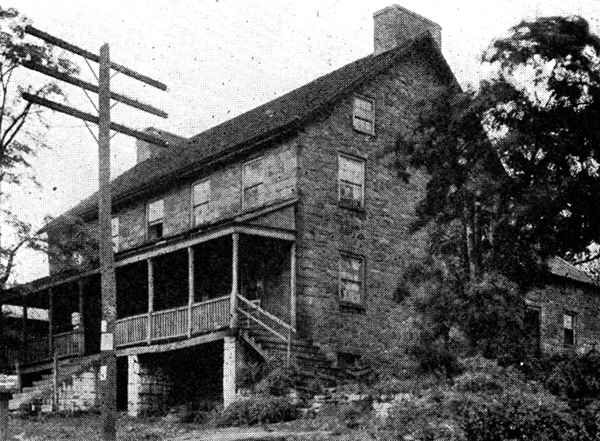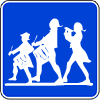 |
Searight House (site)
Formerly/Also Known As Gray's Tavern, Risler's Tavern, Fry's Tavern, Shaw's Tavern, Rush's Tavern, Searight's Tavern1910
7163 National Pike
Uniontown, PA 15401This landmark is now longer standing.
From Searight's The Old Pike (1894):
Next, two miles further west, is Searights. Here is the old half-way house between Uniontown and Brownsville, a large stone building on the north side of the road, at the crossing of the great drovers' road of other days leading from the Flats of Grave Creek, Virginia, to Bedford, Pennsylvania. The large stables connected with this house, on the opposite side of the road, are still standing, and in a good state of preservation. In the olden time, in addition to the ordinary travel on the road, sleighing and other parties from Uniontown and Brownsville were accustomed to go to this old tavern for a night's dancing, and the attending festivities. This is also the battleground of the memorable 'Gray Meeting' in 1828, where the opposing hosts between Jackson and Adams went into an open field and measured strength by 'counting off,' the Jacksonians outnumbering their adversaries by a decided preponderance, greatly to the mortification of the weaker column. This meeting was called the 'Gray meeting,' because the tavern there was then kept by John Gray, formerly of the Moxley House, before mentioned. The leaders on the occasion of this trial of strength were as follows: On the Jackson side, Gen. Henry W. Beeson, Col. Ben Brownfield, John Fuller, David Gilmore, Larkin S. Dearth. Alexander Johnson, Provance McCormick, William F. Coplan, Henry J. Rigdon, William Hatfield and William Searight. On the Adams side: Andrew Stewart, John Dawson, John M. Austin, Israel Miller, E. P. Oliphant, Chads Chalfant, Stokely Conwell, Levi Springer, Dennis Springer, and William Colvin. Prior to 1840 many of the Democratic county meetings and conventions were held at Searights. Before the era of railroads it was a central point for Uniontown, Connellsville and Brownsville. A large water-trough was always maintained at this old tavern, where teams attached to all kinds of wagons, coaches and other vehicles, as well as horses and mules led in droves, were halted for refreshment. At times relays of stage horses for extra occasions were stationed here, and it was always a relay for the line teams moving merchandise. An old sign-board was displayed at the front of the house for many years, bearing in large gilt letters the legend Searights. The old tavern at Searights was built by Josiah Frost, about the time the National Road was constructed, and in the year 1821 William Searight acquired it by purchase from Frost. Joseph T. Noble as lessee of William Searight kept the tavern first after it was vacated by Frost. It was kept for a brief period at intervals by William Searight, but owing to his absence from home, being a contractor on public works, he did not give the management his personal attention, but placed it in the hands of James Allison, a well remembered and highly esteemed citizen, subsequently and for many years postmaster at Searights. John Gray, as has been stated, kept this house in 1828. He was succeeded by John Risler, the noted old tavern keeper, before mentioned. Mrs. Risler's mother died at this house. Her name was Marsh. After Mr. Risler left, and about 1840, Matthias Fry went into possession, and conducted the house for a number of years. He had been a popular old wagoner, and drew a large wagon trade. He was succeeded by Joseph Gray, son of John, before mentioned, and father of John Gray, the old railroad conducter. Joseph Gray died in this house in January, 1851. He was a worthy citizen, well deserving of honorable mention. After the death of Joseph Gray the house was kept first by William Shaw, known as 'Tavern Keeper Billy,' and after him by William Shaw, known as 'Wagoner Billy.' These two Shaws were not of kin. In 1856 Henry Clay Rush took charge of the house and remained in it until 1863, when he purchased the Moxley property and removed to that point, as before stated. Rush was a popular man, and was liberally patronized by the traveling public. In the fall of 1862, or winter of 1863, the mansion house of Ewing Searight was destroyed by fire, and he moved to the old tavern when Rush vacated it, remained for a while, and subsequently from time to time leased it to James Frost, Alfred McCormick, Thomas Allen, C. W. Downer, Robert Moxley, Lewis Fry and James W. Claybaugh. During the terms of the last mentioned persons the patronage of the house was mostly local. The house is now the private residence of William Searight, a son of Ewing Searight, owner of the property, and late superintendent of the road. William Searight, the old proprietor, was superintendent of the road for many years, during its flourishing era.
View user comments below.
|
 |
 |
Searight House. Photograph by John Kennedy Lacock and Ernest K. Weller, 1910.
|
No comments have been posted.
Feedback: Do you have corrections or contributions for this page? Want to make a suggestion? Click here to send me an e-mail. I am espcially interested in memories, stories, postcards and photographs. Thanks!

Last updated: 2014-04-05 13:40:59 |
 |
|


|
|
































